Thinking about how to retire in Mexico? You’re in good company. Every year, thousands of retirees from the United States, Canada, and other countries choose Mexico for its affordable cost of living, warm climate, vibrant culture, and proximity to North America. It’s no surprise that Mexico is now one of the world’s most popular retirement destinations.
This guide will walk you through everything you need to know about retiring in Mexico in 2025. You’ll learn about the retirement visa Mexico requires, the income requirements to retire in Mexico, and practical details like healthcare, lifestyle, and housing costs. We’ll also highlight the best places to retire in Mexico, from colonial towns to coastal escapes, so you can find the destination that feels right for you.
Retirement abroad takes planning, but it doesn’t have to feel overwhelming. By the end of this blog, you’ll have a clear roadmap to make your retirement in Mexico smooth, affordable, and enjoyable.
Table of Contents
- Why Retire in Mexico? The Pros and Cons
- The Mexico Retirement Visa: A Legal Requirement
- How Much Money Do You Need to Retire in Mexico?
- Best Places to Retire in Mexico in 2025
- How to Retire in Mexico: Practical Steps to Take Before & After Your Move
- Common Challenges and How to Overcome Them
- Conclusion: Is Mexico Right for You?
Why Retire in Mexico? The Pros and Cons
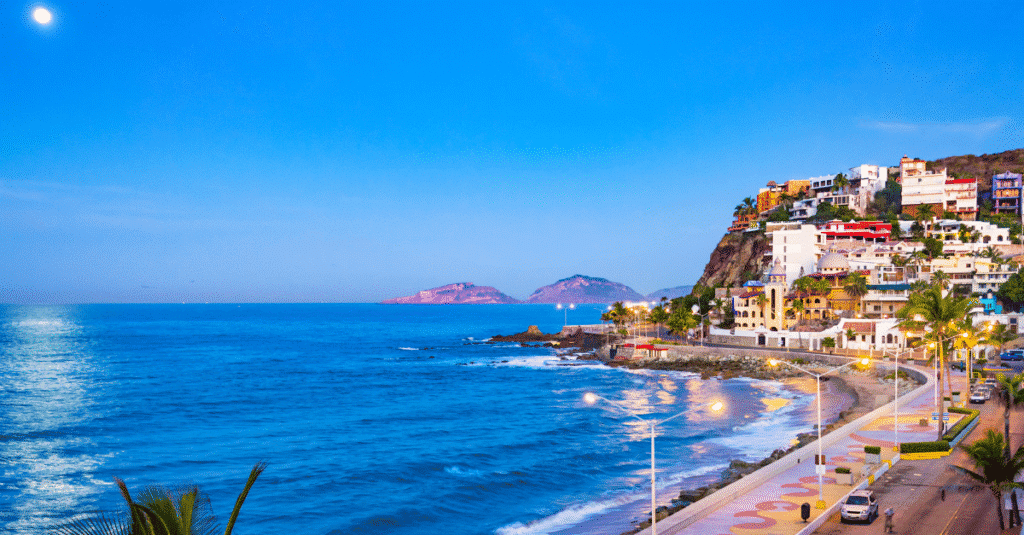
Many expats are drawn to retiring in Mexico for its affordability, lifestyle, and closeness to home. While there are some challenges to prepare for, the benefits usually outweigh the drawbacks.
The Pros
- Low Cost of Living
Everyday expenses like groceries, housing, dining, and domestic help are significantly more affordable than in the U.S., Canada, or much of Europe. This allows many retirees to stretch their pensions or savings further. - Affordable Healthcare
Mexico offers both private and public healthcare options at a fraction of the cost compared to the U.S. Many doctors are U.S.-trained, and major cities have modern hospitals. - Diverse Landscapes
Whether you prefer sunny beaches, bustling cities, or mountain retreats, Mexico offers a wide variety of environments to suit different retirement lifestyles. - Vibrant Culture and Food
Mexico is rich in history, traditions, festivals, and, of course, world-renowned cuisine. Retirees often find that life here feels lively and fulfilling. - Proximity to the U.S.
For American retirees in particular, Mexico’s close location means shorter and often cheaper flights back home to visit family and friends.
The Cons
- Bureaucratic Hurdles
Visa applications, residency renewals, and other administrative processes can be time-consuming and sometimes frustrating, especially if you do not speak Spanish. Patience (and legal help) can make these processes much smoother. - Potential Safety Concerns
While many expat-friendly areas are safe, crime and safety issues do exist in certain regions. Careful research into the location you choose is essential. - Adjusting to Cultural Differences
Slower pace of life, different attitudes toward time, and varied approaches to service can take some getting used to. Remember, it’s important to embrace the culture of your new home. - Language Barrier
While you can get by with English in tourist and expat hubs, learning at least basic Spanish is important for integration and for navigating daily life more easily. Additionally, locals will appreciate the effort you make.
In short, Mexico offers retirees an excellent quality of life at an affordable cost. It is important to plan ahead for the challenges of living abroad, and understanding why so many people choose to move to Mexico can help put your decision into perspective.
The Mexico Retirement Visa: A Legal Requirement
If you plan to stay in Mexico for more than a few months, you’ll need a valid residency visa. Tourists can visit for up to 180 days, but retirees who want to live in Mexico long-term must apply for either the Temporary Resident Visa (Residente Temporal) or the Permanent Resident Visa (Residente Permanente).
The Temporary Resident Visa (Residente Temporal)
This visa is designed for foreigners who want to live in Mexico for more than 180 days but less than four years. It’s often the first step for retirees who want to experience life in Mexico before committing to permanent residency.
Income Requirements (2025 estimates)
Financial thresholds are tied to Mexico’s minimum wage and updated annually. For 2025, applicants should be ready to show either:
- Monthly income: About $4,300 USD from pensions, retirement accounts, or other stable sources.
- Savings alternative: About $73,000 USD in savings or investments.
Application Process
- Begin at a Mexican consulate outside Mexico (usually in your home country).
- Once approved, the visa is stamped into your passport.
- On arrival in Mexico, exchange it for a resident card at the Instituto Nacional de Migración (INM).
The Permanent Resident Visa (Residente Permanente)
This option is for retirees who want to live in Mexico indefinitely. It’s best suited for those confident about making a long-term move.
Income Requirements (2025 estimates)
The requirements are higher since this visa grants indefinite residency:
- Monthly income: About $7,300 USD.
- Savings alternative: About $293,000 USD in savings or investments.
Application Process
There are two ways to qualify:
- After Temporary Residency: Transition to permanent status after holding a Temporary Resident Visa for four years.
- Direct Application: Apply directly at a Mexican consulate if you meet the higher financial thresholds.
General Document Checklist
- Valid passport
- Completed visa application form
- Passport-sized photos
- Proof of income (pension, retirement, or bank statements)
- Proof of savings (usually covering 12 months)
- Consular fee payment receipt
How Much Money Do You Need to Retire in Mexico?

One of the main reasons retirees choose to retire in Mexico is its lower cost of living compared to the U.S., Canada, and much of Europe. However, your expenses will vary based on location, lifestyle, and healthcare needs. Below is a breakdown of typical costs to help you plan your retirement budget.
Cost of Living by Location
- Major Cities (Mexico City, Monterrey, Guadalajara): Higher housing and service costs, though still more affordable than U.S. urban centers.
- Tourist Hubs (Cancún, Playa del Carmen, Los Cabos): Prices tend to be inflated, particularly for rentals and dining.
- Smaller Towns and Inland Cities (Mérida, Oaxaca, San Miguel de Allende): Often significantly cheaper, with lower rent and daily expenses.
Housing
Housing is typically the largest monthly expense.
- Renting an Apartment: $500–$1,200 USD per month, depending on size and city.
- Purchasing Property: Popular with retirees, especially in smaller towns, where prices can be significantly lower than in the U.S.
Healthcare
Mexico offers both private healthcare (high quality and affordable compared to the U.S.) and access to public healthcare systems for residents.
- Private Insurance: $1,500–$3,000 USD annually, depending on age and coverage.
- Out-of-Pocket Costs: Routine doctor visits can cost as little as $30–$50 USD.
Groceries and Utilities
- Groceries: $200–$400 USD per month, depending on diet and shopping habits.
- Utilities (electricity, water, gas, internet): $100–$200 USD per month, though air conditioning in coastal areas can increase electricity bills.
Transportation
- Public Transportation: Very affordable, with bus fares often under $1 USD.
- Car Ownership: Fuel and maintenance are cheaper than in the U.S., but it’s important to factor in insurance and import taxes.
Lifestyle
Your lifestyle will greatly influence overall expenses. Dining out is affordable, with meals at local restaurants costing $5–$10 USD. Entertainment, travel within Mexico, and memberships (such as gyms or clubs) can add $200–$500 USD monthly.
Post-Completion (Visa & Legal Costs)
Don’t forget to budget for visa application fees, legal assistance, and ongoing residency costs. Temporary Resident Visa fees can range from $200–$500 USD, and renewals are required annually until you qualify for permanent residency.
Best Places to Retire in Mexico in 2025
One of the biggest advantages of retiring in Mexico is the sheer variety of places you can call home. Whether you’re looking for a cosmopolitan city, a charming colonial town, or a beachside paradise, there’s a destination to fit every retirement lifestyle and budget. Below we have listed some of the most popular retirement spots in Mexico in 2025:
San Miguel de Allende
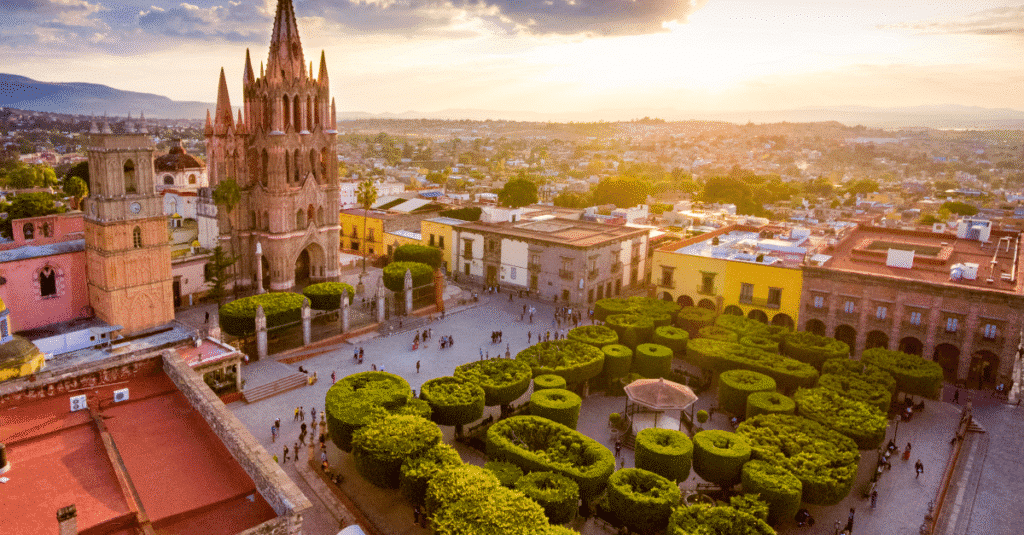
Known for its cobblestone streets and thriving arts scene, San Miguel de Allende has long been a favorite among retirees. There’s always entertainment to look forward to with the city’s vibrant cultural calendar, world-class dining, and a strong expat community that makes integration easier. It’s especially appealing if you’re looking for a mix of history and modern comforts.
Puerto Vallarta

If you’re dreaming of life by the beach, Puerto Vallarta might be the perfect fit. Nestled on Mexico’s Pacific coast, it combines stunning beaches with a buzzing culinary and nightlife scene. It’s convenient to travel in and out of the city as it has its own international airport, a plus for retirees who want to maintain close ties to family abroad.
Lake Chapala
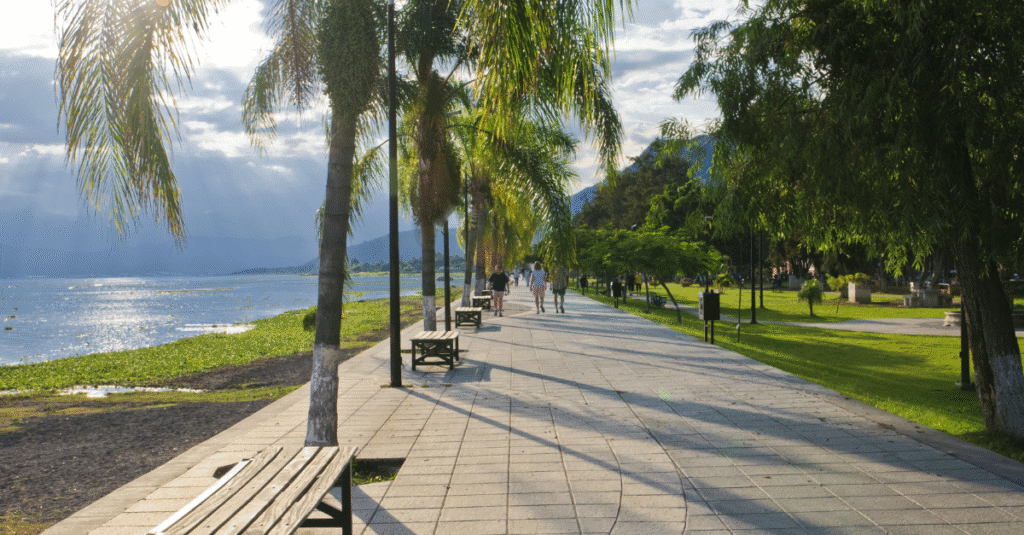
Home to Mexico’s largest expat community, Lake Chapala is a top choice for retirees seeking affordability and a welcoming environment. The area boasts a comfortable year-round climate, affordable housing, and plenty of activities geared toward retirees. English is widely spoken, which helps ease the transition for newcomers.
Mérida
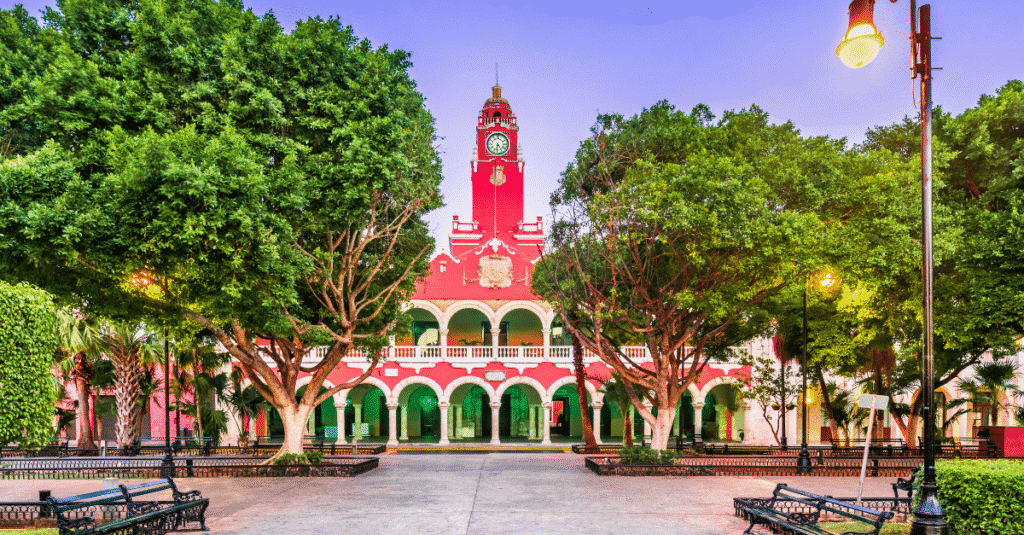
Located in the Yucatán Peninsula, Mérida is known for its safety, rich Mayan heritage, and lower cost of living. The city offers a slower pace of life, excellent healthcare options, and vibrant cultural traditions. It’s definitely worth considering if you want to immerse yourself in authentic Mexican culture while still enjoying modern conveniences.
Los Cabos & the Riviera Maya
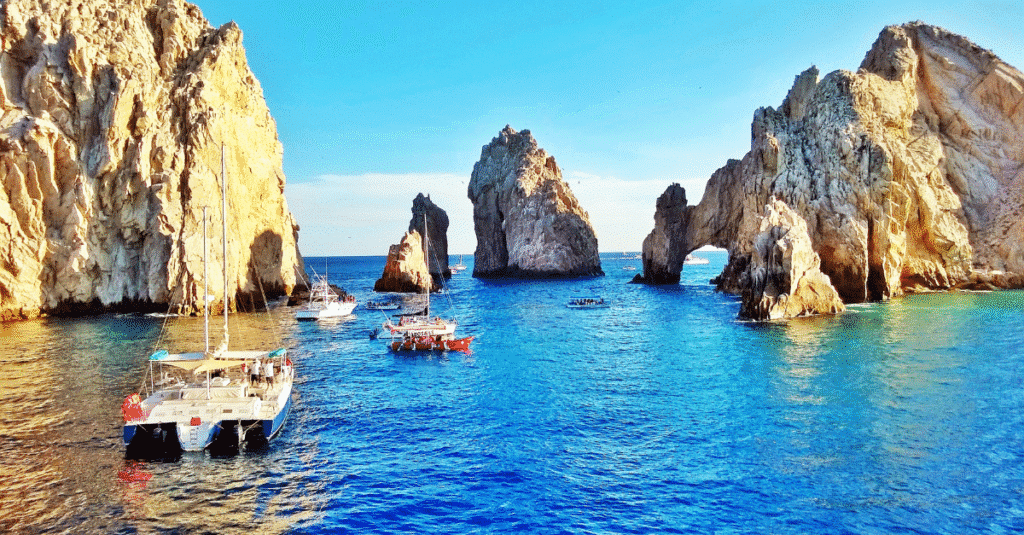
For retirees who prefer luxury living, Mexico’s resort destinations like Los Cabos and the Riviera Maya deliver world-class beaches, golf courses, and high-end amenities. These areas tend to be more tourist-oriented, which means higher prices than other regions, but they offer unparalleled natural beauty and access to modern infrastructure.
Choosing Your Retirement Destination
Each of these locations offers something unique. Whether it’s the artsy vibe of San Miguel de Allende, the laid-back coastal living of Puerto Vallarta, or the cultural depth of Mérida. When planning your retirement in Mexico, consider your budget, desired lifestyle, and healthcare access. The variety of options makes it possible to find a location that matches your personal retirement goals, whether that’s peace and quiet, an active expat scene, or resort-style living.
How to Retire in Mexico: Practical Steps to Take Before & After Your Move
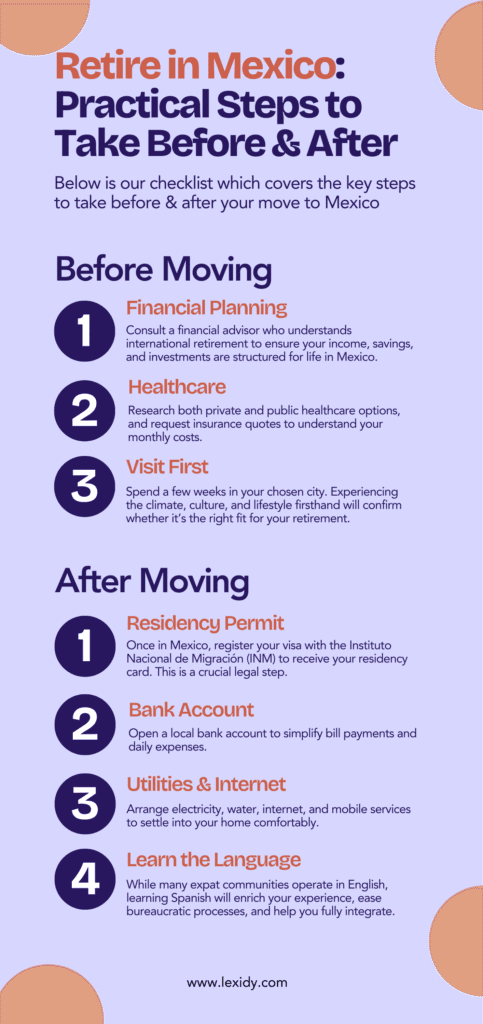
Retiring in Mexico doesn’t just require securing a visa. Relocating involves planning your finances, healthcare, and day-to-day life. Here are some key steps to make the transition smoother.
Before Moving
- Financial Planning: Consult a financial advisor who understands international retirement to ensure your income, savings, and investments are structured for life in Mexico.
- Healthcare: Research both private and public healthcare options, and request insurance quotes to understand your monthly costs.
- Visit First: Spend a few weeks (or months, if possible) in your chosen city. Experiencing the climate, culture, and lifestyle firsthand will confirm whether it’s the right fit for your retirement.
After Arriving
- Residency Permit: Once in Mexico, register your visa with the Instituto Nacional de Migración (INM) to receive your residency card. This is a crucial legal step.
- Bank Account: Open a local bank account to simplify bill payments and daily expenses.
- Utilities and Internet: Arrange electricity, water, internet, and mobile services to settle into your home comfortably.
- Learn the Language: While many expat communities operate in English, learning Spanish will enrich your experience, ease bureaucratic processes, and help you fully integrate.
Navigating visas and residency rules can feel overwhelming, which is why many retirees turn to an experienced immigration lawyer in Mexico. Explore how professional guidance can simplify your move and give you peace of mind.
Common Challenges and How to Overcome Them

Retiring in Mexico can be deeply rewarding, but like any international move, it comes with challenges. Being aware of these in advance and knowing how to handle them will make your transition much smoother.
Bureaucracy
Administrative processes in Mexico can be slow and sometimes confusing.
Approach paperwork with patience, keep multiple copies of all required documents, and consider hiring a Mexican immigration expert to guide you through residency, property, and banking procedures.
Healthcare
While Mexico offers excellent healthcare options, navigating the system can feel overwhelming at first.
Research both public (IMSS, INSABI) and private healthcare facilities in your area. Many retirees opt for private insurance to ensure faster access to doctors and hospitals. Establish a plan before you need care.
Cultural Differences
Life in Mexico moves at a different pace, and communication styles may differ from what you’re used to.
Keep an open mind, embrace the cultural differences, and practice patience. Engaging with locals and learning Spanish will help you adapt more easily.
Safety
Mexico is a vast and diverse country, and safety varies greatly by region. While some areas face challenges, many retirement hubs are safe and welcoming.
Research thoroughly before deciding where to settle, rely on updated local information, and follow common-sense precautions just as you would in any other country.
Conclusion: Is Mexico Right for You?
Retiring in Mexico offers a rare balance of affordability, cultural richness, and lifestyle benefits that few destinations can match, often at a fraction of the cost of living back home.
A successful transition requires planning. Understanding visa requirements, preparing financially, researching healthcare options, and adapting to cultural differences will ensure a smoother move.
If you’re serious about retiring in Mexico, start with a research trip, consult professionals who specialize in international retirement, and connect with expat communities for firsthand insights. With the right preparation, Mexico can be more than just a place to retire. It can be the beginning of your next great adventure.
If you’re ready to make the first steps towards retiring in Mexico, fill out the form below. Our Mexico immigration experts will be in touch.

